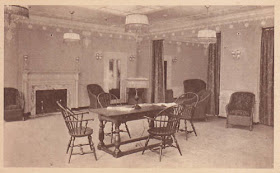Hello, Lovecraftians!
It was brought to my attention that I may have missed a posting day! Thank you for your keen eyes, and all is well with Chrispy.
I have to admit, the pace can be grueling to keep up with the ol' blog, and once in a while I do get distracted, or accidentally miss a day. I tend to work 30 days out on posts (I tend to set them for 12:01 AM EST), and sometimes I miss a day from bleary 1 AM int he morning eyes, or the post misfires into draft mode. Such the vagaries of doing a blog behind the scenes.
Posts are unpredictable. They can be simple cut and paste when someone sends me a ready-to-use email, but a lot of times it takes a minimum of an hour per post to format, crop pictures, write text, do html, and so forth. (No extra charge for my creative typos).
A Houdini post I have set for 2 September 2010 took me most of two hours to research, as the poster-image was misrepresented on numerous other blogs and web sites with the wrong dates - the wrong year. The Hope High School stuff I have probably put 100 hours into reading old texts stored on Da Google to see if anything pertains tangentially to Lovecraft and his historical context. I think I'm close to memorizing some of the antique city directories and city hall books. It's like time traveling. I walk out of gas-light and street-cars era and hop into my car to drive to work and think, "Wow, the 21st century really looks weird." But I'm not giving up the microwave and cell phone.
I now carry around in my briefcase odd bits. Right now I have a 1943 copy of a Lovecraft set of memoirs, an original Coates Driftwind, printouts of perpetual calendars, and four thick, college-ruled notebooks with every single day listed between 1894 and 1910. And I have the individual lines filled with every scrap of Lovecraft and Providence trivia and minutiae I can find. Now, how do I find time to type it into a manuscript!
In other matters, I have several mysteries that I am attempting to unravel of either Lovecraft or his legacy, his history and his historicity. Oh to have a smoking gun letter where Houdini offers Lovecraft a job as a spy! Or some scrap of Lovecraft from late summer of 1908!
I do have other interests! I finished Dr. E O Wilson's new (and first) book of fiction called Anthill. It's worthy. I have a huge stack of to-be-read horror fiction. I try to keep up with my "Weird Beasts" column at Dark Recesses. I'm an avid listener of Caost to Coast. Mrs Chris and I have burned through all the seasons on DVD of Ghost Hunters (Jason and Grant rock!), and most of UFO Hunter on DVD. Just got some new Southern Gospel CD's, and Dierks Bentley's new release is waiting in the car for me. Plus I discovered another addictive zynga game to experiment with - Frontierville. (I'm at level 820+ in Mafia Wars.) :)
Alas, the spam continues, so I have the comment section completely turned off. If you make a comment, please try to use some Indo-European language group I can read or translate via Google translator. Otherwise I really can't moderate it and have to delete it.
Keep those e-cards and e-mails coming in gang! I read 'em all, and answer as fast as I can.
-Chrispy.
























.jpg)


















